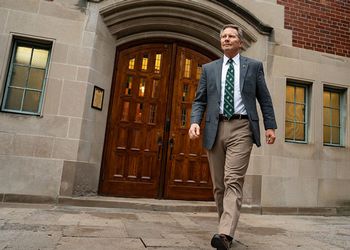Feature: Diagnostic Center for Population and Animal Health Opens

A new center at MSU will help avert the kind of catastrophic health disaster that occurred in the 1970s with the PBB crisis.
In 1973 more than 10,000 southern Michigan residents (mostly farm families and their neighbors) and their animals were accidentally exposed to about 1,000 pounds of polybrominated biphenyls—PBBs. The flame retardant “FireMaster,” which contained PBB, was mistaken on a shipping dock for the cattle food “NutriMaster” and mixed with animal feed.
Before the mixing error was discovered, thousands of cows, pigs, and chickens were affected, as were the people who ate meat, milk, and eggs from the contaminated animals. A disaster of considerable proportions emerged, and in its wake, the state of Michigan established the Animal Health Diagnostic Laboratory at Michigan State University to guard against future such events.
Since that time, the lab, now called the Diagnostic Center for Population and Animal Health, has become one of the country’s premier and busiest veterinary diagnostic laboratories. From just over 9,700 submissions when it first opened, it has grown to about 170,000 submissions and more than 1.2 million diagnostic tests per year.
During the ‘90s, testing of wild animals at the diagnostic center increased by 835 percent, mostly because of the discovery of bovine tuberculosis in white-tailed deer and subsequently in some beef and dairy cattle herds.
“The diagnostic center has been an important partner with the state in determining the extent of the bovine TB problem and working to solve it,” says Dr. Willie Reed, director of the Diagnostic Center for Population and Animal Health.
Then came West Nile virus and surveillance for chronic wasting disease, “mad cow” disease, and a seemingly endless number of emerging pathogens.
By the late ‘90s, it had become clear that the diagnostic center had outgrown its facilities, and the state of Michigan appropriated $58 million to construct a new, 153,000- square-foot, state-of-the-art building. A phased move into the new building began on Feb. 12.
It consolidates into one location veterinary expertise in bacteriology/mycology, endocrinology, epidemiology, immunodiagnostics, molecular pathology, nutrition, parasitology, anatomic pathology, serology, toxicology, and virology. Clinical pathology will remain in the Veterinary Teaching Hospital. The Michigan Department of Natural Resources’ Wildlife Health Laboratory also has space in the new facility.
“The state has clearly recognized that a veterinary diagnostic center is important not only to the health of animals and the state’s economy, but also to human health,” says Reed. “That relationship is becoming more clear to average citizens as well, as they hear nightly on the news about such things as SARS, avian influenza, Hanta virus, and mad cow disease, which have all jumped species barriers.”
Cases in animals are often the first warning that human cases may soon follow and a signal to take the appropriate measure to protect the human population.
“A good example: We diagnosed West Nile virus in Michigan birds well before there was a human case here,” Reed explains, “and that gave the public health people a head start in warning people and putting out recommendations on how to avoid infection.”
Special features of the new diagnostic center are the biosafety level 3 microbiology laboratories and BL3 necropsy (autopsy) areas, which provide the necessary environment to conduct analyses and tests on “high-consequence” livestock and zoonotic pathogens.
“There are areas where you want a high level of containment, and the presence and amount of BL-3 space in our new facility is unprecedented,” Reed notes. “We are the only veterinary diagnostic lab in the U.S., if not the world, that has a large-animal BL-3 necropsy area.”
Also unprecedented are the systems to handle infectious waste, both solid and liquid.
“Our new facilities will allow us to run some tests that we previously had to send out of state, and that will provide a faster turnaround on items that are critical for public policy decisions,” Reed says.
The sheer size of the new diagnostic center makes it unusual; it is already one of the busiest in the country, according to Reed. The number and variety of the center’s individual components and the diversity of services are also unique.
Being involved in this project has been consuming but rewarding to Reed.
“It’s been a tremendous opportunity to be part of the process to design and build a state-of-the-art building that will provide for the current and future needs of the people of the state of Michigan,” he says. “It’s been inspiring to think that this building will be here long after I’m gone.”
author’s note: Linda Chadderdon, ’69, is the communications manager of the College of Veterinary Medicine.



